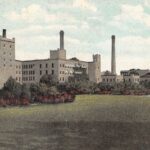On the evening of October 8, 1871, the most destructive fire in U.S. history blazed through seventeen towns in northeast Wisconsin. In total, the Peshtigo Fire burned 2,400 miles of land, killed anywhere from 1,200 to 2,500 people, and injured another 1,500. Some of those who survived were able to do so by jumping and wading in the Peshtigo River. There are many eyewitness accounts left behind, one states: “the air was literally filled with burning coals and cinders, which fell, setting fire all around.”[1] The fire was able to burn and spread quickly due to the wind direction, the dry summer that year, and the amount of slash and saw dust in the lumbering town.
After the fire finally died out, survivors went out to aid other survivors and to help collect the dead. One of these survivors was R.M. Wright. Not much remained of the cities the Great Fire destroyed. Collapsed trees and the remains of burnt animals littered the path of the fire. When Wright reached Williamsonville he saw a pile of 35 dead bodies and even more scattered in other places. Many of the bodies were so badly burnt they could not be identified. However, he identified the body of Miss Maggie Haney by the breastpin still attached to her clothing.
The breastpin is currently on display at the Door County Historical Museum and Archives. Recorded by Thomas Williamson in 1871, Miss Haney’s name appears on a list of the identified victims from Williamsonville in a binder in the Peshtigo Fire Museum.
Written by Morgan Zdroik, July 2020.

FOOTNOTES
ADDITIONAL SOURCES
Sarah Derouin, “Benchmarks: October 8, 1871: The Deadliest Wildfire in American History Incinerates Peshtigo, Wisconsin.” EARTH Magazine, 19 September 2017. Accessed 5 December 2019. https://www.earthmagazine.org/article/benchmarks-october-8-1871-deadliest-wildfire-american-history-incinerates-peshtigo-wisconsin.
History.com Editors, “Chicago Fire of 1871.” History.com, 4 March 2010. https://www.history.com/topics/19th-century/great-chicago-fire.
Tom Hultquist, “The Great Midwest Wildfires of 1871,” National Weather Service. https://www.weather.gov/grb/peshtigofire2
Joseph M. Moran and E. Lee Somerville “Tornadoes of Fire at Williamsonville, Wisconsin, October 8, 1871.” Transactions of the Wisconsin Academy of Sciences, Arts and Letters Vol. 78, 1990.
Peshtigo Fire Museum, “History of the Peshtigo Fire,” Accessed 5 December 2019. http://peshtigofiremuseum.com/fire/.
Justin Skiba, “The Fire That Took Williamsonville,” Door County Pulse, 2 September 2016. https://doorcountypulse.com/fire-took-williamsonville/
Wisconsin Historical Society, “October 8, 1871, the Night Peshtigo, Wisconsin was Destroyed by Fire,” Historical Essay. https://www.wisconsinhistory.org/Records/Article/CS2911
Wisconsin Historical Society, “Peshtigo Fire,” Historical Essay. https://www.wisconsinhistory.org/Records/Article/CS1750.

Door County Museum and Archives
This object is part of the collection of the Door County Museum and Archives in Sturgeon Bay, Wisconsin. Research for this object essay and its related stories was supported by the museum.




